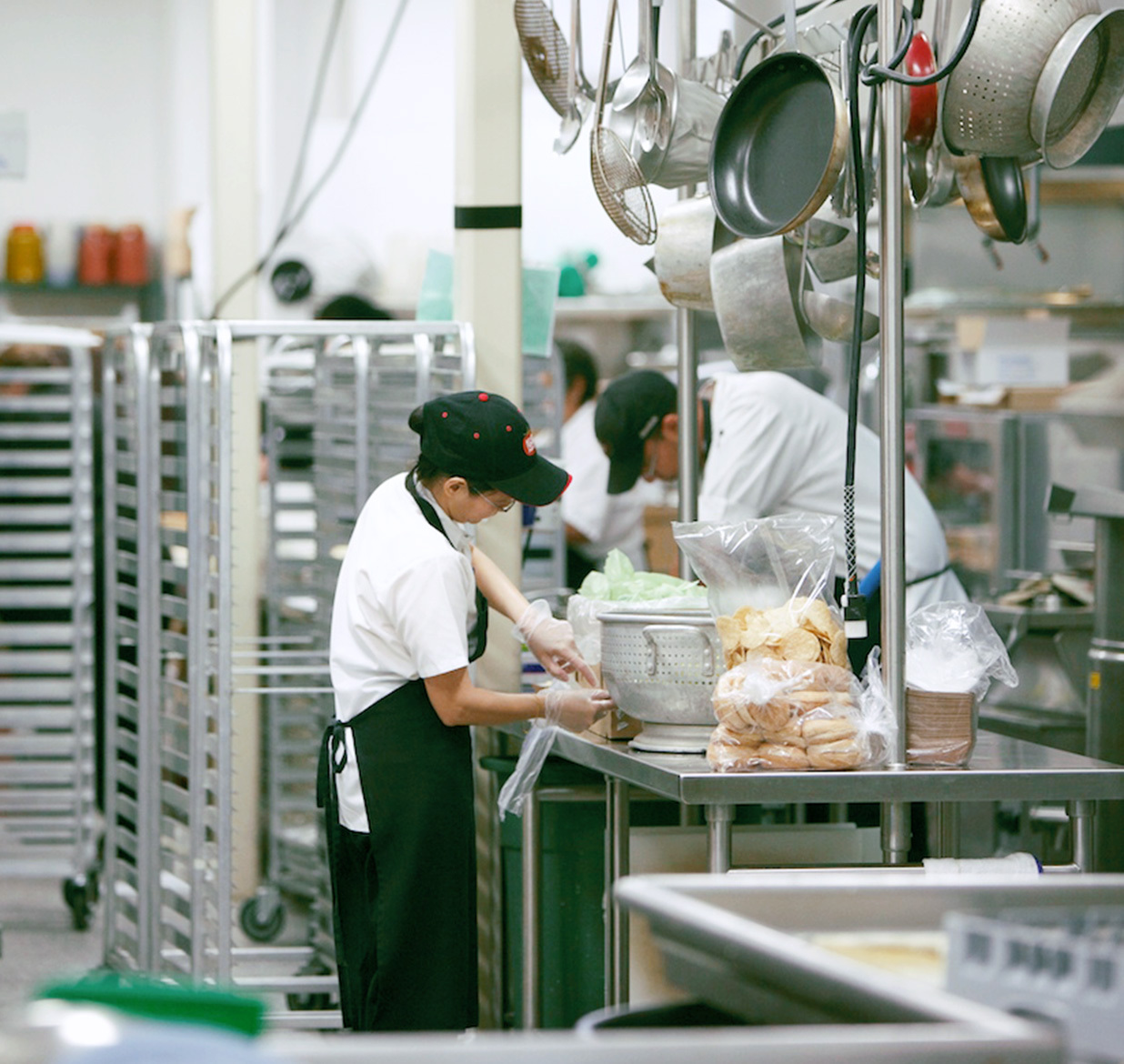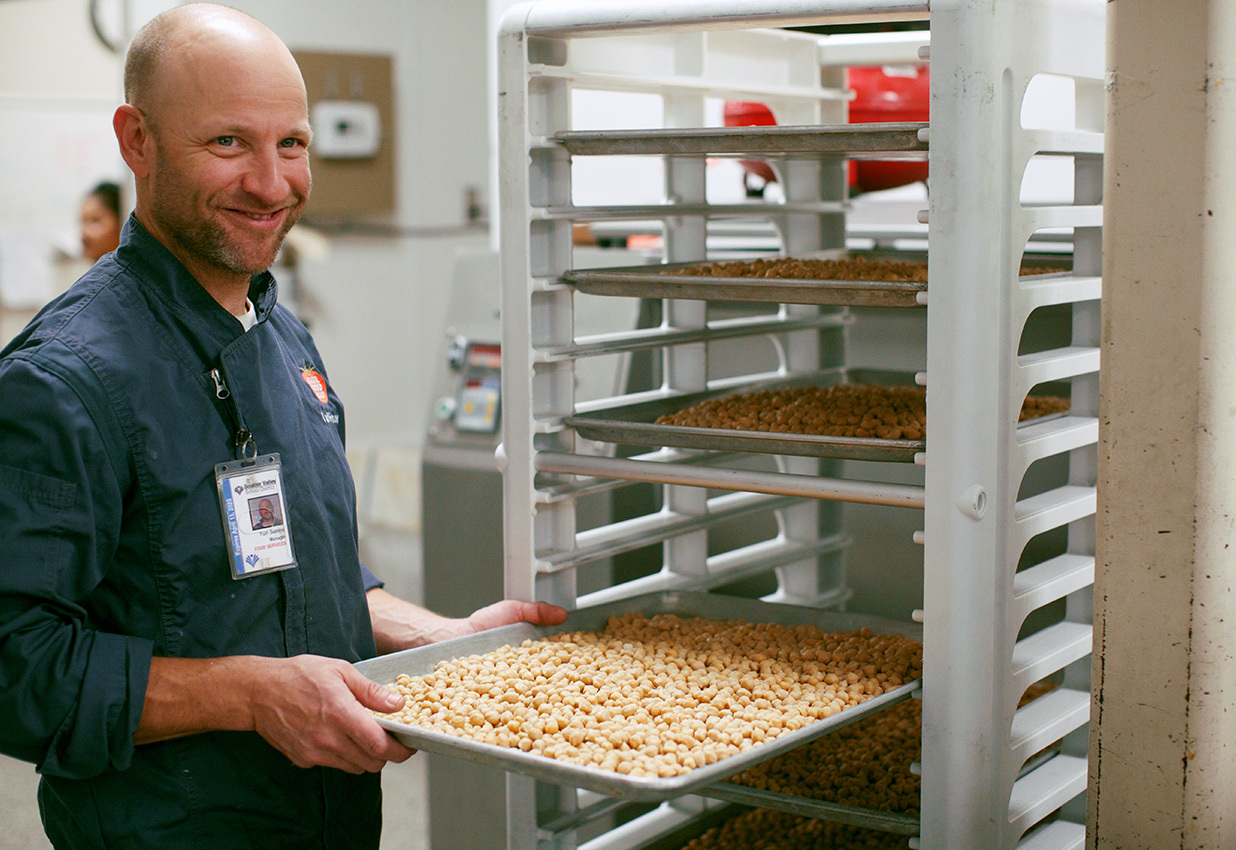
Fiscal Management
Fiscal Management is the process of keeping an organization running efficiently within its allotted budget. Fiscal accountability in food service departments is imperative, especially given the challenge of operating in a highly regulated environment, often with limited revenue, inadequate facilities, and the high personnel costs.
With shifts in the operational model to scratch-cooked meals, meticulous fiscal management becomes even more crucial. With this knowledge, food service directors can lead with full transparency and accountability, enabling them to make informed decisions when developing and growing their programs.
Need a crash course in School Food Finance? Enroll in the School Food Institute course and learn best practices for managing finance in a scratch cook school setting.

Fiscal Management
Fiscal Management is the process of keeping an organization running efficiently within its allotted budget. Fiscal accountability in food service departments is imperative, especially given the challenge of operating in a highly regulated environment, often with limited revenue, inadequate facilities, and the high personnel costs.
With shifts in the operational model to scratch-cooked meals, meticulous fiscal management becomes even more crucial. With this knowledge, food service directors can lead with full transparency and accountability, enabling them to make informed decisions when developing and growing their programs.
Need a crash course in School Food Finance? Enroll in the School Food Institute course and learn best practices for managing finance in a scratch cook school setting.
Why Fiscal Management?
The Case for Fiscal Management
District size can often determine the extent of the food service director’s fiscal management responsibilities. In smaller districts (those with fewer than 2,499 students), the accounting department may manage much of the food service budget and advise as needed on financial issues.
The district’s business manager may view food services simply as a line item without regard to the greater vision of the department’s impact on students’ well-being and the school community. For the food service director in a smaller district, envisioning a change of their food service department will require learning new processes and using tools for oversight to make informed decisions. They must be able to explain their plan to the business manager with adequate analysis as back-up.
In larger districts, the food service director is generally more involved in the processes related to their fund. They may have budgetary responsibility and a detailed understanding of both food and payroll costs. In these districts, the accounting department may support food services by providing basic accounting services such as bank deposits, check writing, and other accounting functions. But typically, the expectation is that the food service director makes the decisions regarding their fund’s operation, including payroll and food expenditures.
Although federal regulation mandates that food service department funds should be budget neutral, in some cases food services will need additional support from the district’s general fund. District administration may attempt to reduce the transfer of funds from the general fund to the food services fund, and a common response is to cut expenditures without considering strategies to increase revenue and participation. This produces a culture that sabotages the creative problem-solving necessary to improve food quality and student participation, and, as a result, increase revenue. This is why the food service director must take charge of the fiscal management of the program; it is the key to a successful and sustainable food program.

“...the food service director must take charge of the fiscal management of the program; it is the key to a successful and sustainable food program.”

“...the food service director must take charge of the fiscal management of the program; it is the key to a successful and sustainable food program.”
Trusted and effective calculation tools can help food services directors manage their funds efficiently. The ability to correlate statistics and make accurate projections allows the department to navigate through unforeseen changes and events, which may be internal to the department or extend to the overall district. These tools can create a common language for discussing changes and reorganization with the district administration and accounting department. The most innovative districts have a thorough understanding of their bottom line and can articulate how a robust food service is a vital part of the educational program.
The Management Tools & Resources page contains easy-to–use, downloadable spreadsheets that can be used in conjunction with district-wide financial systems, Point-of-Sale software (POS—meal counts by eligibility used to claim reimbursement), and back-office software (back of the house software—recipe management, menu cycles, purchasing records, inventory, and production records). Very small districts that do not have any of the software mentioned above can use the Lunch Box tools as stand-alone management tools.
All of these tools provide a benchmark to evaluate the progress and success of potential program changes such as universal breakfast, centralizing production, labor shifts, or menu shifts to increase participation. The tools can also be used to create projections by developing “what if” scenarios for shifts in labor assignment or a full reorganization.

Labor Costs
Labor costs generally account for 45–50% of a food service department’s budget. However, depending on the location, minimum wage adjustments, and negotiated agreements, the percentage of labor expenditures can reach much higher.
It is vital to accurately project this budget and ensure that you have the correct staffing in place to produce quality meals in a timely manner. Most districts develop their personnel budgets with software tied to the payroll system. Typically, this software does not provide all of the information needed by the food service department to manage current personnel or to plan for future change; when planning any change to the department’s programs, food services must be able to forecast the staffing requirements for the changes and then monitor the results.

Labor Costs
Labor costs generally account for 45–50% of a food service department’s budget. However, depending on the location, minimum wage adjustments, and negotiated agreements, the percentage of labor expenditures can reach much higher.
It is vital to accurately project this budget and ensure that you have the correct staffing in place to produce quality meals in a timely manner. Most districts develop their personnel budgets with software tied to the payroll system. Typically, this software does not provide all of the information needed by the food service department to manage current personnel or to plan for future change; when planning any change to the department’s programs, food services must be able to forecast the staffing requirements for the changes and then monitor the results.
Labor Cost Tools
Position Control Worksheet
An easily manipulated worksheet to identify personnel by site; provides details of each employee’s associated costs, such as health and welfare, number of days, etc.
Hours Assigned to Hours Worked Worksheet
Track assigned/budgeted hours compared to actual hours worked.
Meals Per Labor Hour Worksheet
Compare site labor allocations to meals provided. [Spanish Version]


Labor Cost Tools
Position Control Worksheet
An easily manipulated worksheet to identify personnel by site; provides details of each employee’s associated costs, such as health and welfare, number of days, etc.
Hours Assigned to Hours Worked Worksheet
Track assigned/budgeted hours compared to actual hours worked.
Meals Per Labor Hour Worksheet
Compare site labor allocations to meals provided. [Spanish Version]

POSITION CONTROL
The food service department’s labor cost requires strong management and planning, as it represents one of the largest portions of the expenditures. The annual cost for each operationally-necessary position is calculated based on the salary of the current employee (or an estimate if the position is open), as well as the other incremental costs (aka fringe benefits) associated with that position: pension payments, FICA, Medicare, and healthcare.
Variable attributes such as job title, pay range, collective bargaining affiliation, location, available health plans, retirement, work calendar, and allotted hours are also assigned to each position. As soon as people are hired for open positions, their unique information—such as date of hire, placement on the salary schedule, and health plan selection—should be updated in the calculations.

POSITION CONTROL
The food service department’s labor cost requires strong management and planning, as it represents one of the largest portions of the expenditures. The annual cost for each operationally-necessary position is calculated based on the salary of the current employee (or an estimate if the position is open), as well as the other incremental costs (aka fringe benefits) associated with that position: pension payments, FICA, Medicare, and healthcare.
Variable attributes such as job title, pay range, collective bargaining affiliation, location, available health plans, retirement, work calendar, and allotted hours are also assigned to each position. As soon as people are hired for open positions, their unique information—such as date of hire, placement on the salary schedule, and health plan selection—should be updated in the calculations.
Professional Development in Position Control
Time and resources for professional development are another important element of routine annual expense in position control. This is an area of the budget that is often missing in districts that want to expand their program models. In fact, it is common to have as little as a half-day allocated for a start-up meeting, a few hours for receiving and opening orders prior to the school year, and some extra hours for closing the site down at the conclusion of the school year, with no time or expense allocated for professional development.
As directed by the Healthy, Hunger-Free Kids Act of 2010, the USDA published the final rule on Professional Standards for school food service employees:
- Directors must complete 12 hours of annual training.
- Managers must complete 10 hours of annual training.
- All other staff working a minimum of 20 hours per week must complete 6 hours of annual training.
- Part-time employees working less than 20 hours a week must complete 4 hours of annual training.
- Per the USDA: “At least 8 hours of food safety training is required either not more than 5 years prior to their starting date or completed within 30 calendar days of employee’s starting date.”
Though some districts try to accomplish at least some of the USDA Professional Standard training requirements within the regular work day, for districts shifting to scratch-cooking, budgeting for professional development provides the necessary and cost-saving opportunity to establish new skills and refresh forgotten ones. We recommend budgeting 2 - 3 days of professional development per school year for all site leads and other key management personnel. At least one 8-hour training day should be budgeted for staff who work 20 hours a week or less. If your district is undergoing a major shift in operations, additional one-time training time is incredibly useful in setting up the next stages for success.
In fiscal management, the Position Control Worksheet is the basis for approving positions for the department’s budget. Most district accounting systems have a position control module, which can export a spreadsheet of personnel data that is similar to this tool. This worksheet must be as accurate as possible to ensure the reliability of the personnel budget, and can regularly compare to the actual personnel expenditure by the department. As a cost controlling tool, the position control worksheet should be a living document that reflects your current plan to produce quality meals and service for your students. If the personnel budget changes, you should inform the accounting office so the district financial system mirrors your budget.
Hours Assigned to Hours Worked
Tracking labor activity across all positions is powerful information for fiscal accountability. Some districts use time clock systems for this purpose, which can enhance the ease of the task, but manual timesheets can function in the same way. Once the assigned hours are identified, it is essential to perform a monthly comparison to the actual hours worked to make sure that the hours are within the expected budget. Some payroll systems have “exception reports” that can provide information about hours worked in excess of the assigned or contracted hours; however most school payroll departments do not provide this type of vital information to the departments.
In the absence of an exception report, you can establish your own process for comparing hours assigned to hours worked by creating a report that shows the actual paid hours by employee and comparing those to assigned hours. Because there are many different kinds of payroll systems and pay periods, we cannot provide “the best” tool. However, we have provided the Hours Assigned to Hours Worked Worksheet as an example to help you understand the concept. You can develop a format that fits your department’s needs.
This tracking is important because if hours worked are greater than the assigned hours, then your department will exceed its payroll budget before the year is complete unless the extra hours are to backfill a vacant position. In some cases, this is reasonable and expected, but you need to be prepared to explain the discrepancy. For example, you may have adjusted labor assignments due to enhanced programming—like adding breakfast in the classroom—which may have required an hour or two more a day over the cafeteria-based model. In this particular example, the increased revenue from the program expansion balances the increased labor assignment.
Conversely, additional hours can simply happen without cause. Regularly-occurring extra minutes worked across each site can add up and throw the budgeted labor out of sync with revenue and other expense areas. Establishing clear protocols for approving additional or overtime hours is important to the fiscal health of your department. Performing hours worked to hours assigned comparisons on a routine basis will give you the ability to respond quickly to imbalances and to make necessary changes.

Meals Per Labor Hour
Meals per Labor Hour (MPLH) is one of the most common measurements of productivity that food service departments use when evaluating their sites. MPLH can be calculated to:
- Compare the parity of labor between similar sites.
- Assess the ability of the department to sustain current labor hours.
- Analyze “what-if” scenarios when evaluating the potential efficiency of shift in the production model.
Our Meals Per Labor Hour Worksheet [Spanish Version] is a useful tool to balance staffing between sites. It also provides an indicator of a site’s ability to take on new programs and increased student participation without adding labor costs. In that vein, this calculation can also be used as a tangible illustration for administrators when approval for additional labor is needed due to a significant increase in participation. Additionally, with a complete picture of the overall operation in hand, food service directors can hold proactive conversations with staff when they feel that they do not have adequate time to perform their jobs.
The Calculation
The calculation is relatively simple: take the daily average of all of the meals served at a site and divide by the number of actual labor hours performed. Note: we differentiate “actual” from “budgeted” or “assigned” to account for the actual practice at the site.
- Meals per Labor Hour = Average Daily Meals or Meal Equivalents Served ÷ Number of Actual Labor Hours
Though the calculation is standard across districts, it is difficult to compare one district to another because how they apply the meal equivalent varies. The primary differences are in how meal equivalents are calculated for breakfast and à la carte sales. We recommend the following calculations based on our experience in evaluating numerous districts of various sizes in different parts of the country.


The Calculation
The calculation is relatively simple: take the daily average of all of the meals served at a site and divide by the number of actual labor hours performed. Note: we differentiate “actual” from “budgeted” or “assigned” to account for the actual practice at the site.
- Meals per Labor Hour = Average Daily Meals or Meal Equivalents Served ÷ Number of Actual Labor Hours
Though the calculation is standard across districts, it is difficult to compare one district to another because how they apply the meal equivalent varies. The primary differences are in how meal equivalents are calculated for breakfast and à la carte sales. We recommend the following calculations based on our experience in evaluating numerous districts of various sizes in different parts of the country.
Recommended Meal Equivalents
- Breakfast served before the bell in the cafeteria: 3 to 1
- Breakfast served for universal Grab n’ Go (to the classroom), either as students enter or after first period: 2 to 1
- Universal Breakfast in the Classroom (BIC) served after the bell, delivered to the classroom: 2 to 1
- After School Snack Program packed out for pick-up: 4 to 1
- Lunch: 1 to 1
- Supper: 1 to 1 (unless it a cold pack-out similar to snack)
À la carte sales as a meal equivalents is where The Lunch Box differs from the norm—we don’t count à la carte as a meal equivalent. Here’s why:
- We always recommend selling the reimbursable meal as the primary focus since encouraging kids to choose the planned meals promotes better eating habits and improved health. The reimbursable meal is what our work is really all about.
- Focusing on participation in the reimbursable meal is the most effective way to maintain a fiscally sustainable food service fund. Almost every type of à la carte sale (with the exception of milk) competes with the reimbursable meal and are not necessarily healthy—e.g. two bags of hot Cheetos and Vitamin water.
- The majority of à la carte sales are snacks and beverages that require minimal labor other than inventory management. Labor spent on counting and managing these items is labor that could be focused on improving the food and service quality of the reimbursable meal.
How Many Meals Per Labor Hour?
Determining the acceptable range for MPLH is another part of the equation that varies from district-to-district. One of the most referenced guides for MPLH is found in Pannell-Martin and Boettger’s, School Food Nutrition Management in the 21st Century. Their analysis developed MPLH guidelines that vary depending on the operational model and menu production type (Conventional versus Convenience Systems ).
For example; a school serving 301-400 meals in the Conventional System would be found to range from 14 to 16 MPLH, while the same meal counts meeting the Convenience System description range from 16 to 18 MPLH. Those numbers could be used as a starting point, but are often considered low and depending on the district, conservative MPLH goals may not be fiscally viable. We recommend adjusting a District’s productivity goals to be more relevant to their specific operational model, facilities and budget climate.
When examining labor in schools make sure to consider all the elements surrounding your MPLH goal. For example, elementary sites are often highly productive, so their higher ratios of average daily participation (ADP) are a primary contributor to the district’s bottom line, though the labor assigned to elementary sites is routinely lower, as are the job classifications. Furthermore, if the elementary site is serving in-classroom breakfast models, their MPLH will be even higher. A MPLH range of 28 to 45 is common for an elementary school with classroom breakfast and strong lunch participation.

On the other hand, the less-productive secondary schools require more supervisory staff, multiple service lines, and more menu choices, which translate to a higher labor assignment. Even less productive are some high schools, which are often identified for renovations and upgrades ‒ new equipment, nicer dining areas, high tech POS stations, and lots of staff, but still struggle to attract diners. Food court-style serving areas are a strategy for competing with the nearest fast food outlets; consequently, many high schools relyon à la carte sales to break even, or are simply resigned to operating at a loss.
With these factors in mind, directors can identify opportunities for making adjustments to their labor assignment and creating MPLH targets for similar site types that are effective benchmarks for their districts. It may take a few years of looking, comparing, and adjusting to determine your productivity standard, but consistent evaluation will result in optimized efficiency and higher productivity.
AT LEFT: Illustration of MPLH before and after.

On the other hand, the less-productive secondary schools require more supervisory staff, multiple service lines, and more menu choices, which translate to a higher labor assignment. Even less productive are some high schools, which are often identified for renovations and upgrades ‒ new equipment, nicer dining areas, high tech POS stations, and lots of staff, but still struggle to attract diners. Food court-style serving areas are a strategy for competing with the nearest fast food outlets; consequently, many high schools relyon à la carte sales to break even, or are simply resigned to operating at a loss.
With these factors in mind, directors can identify opportunities for making adjustments to their labor assignment and creating MPLH targets for similar site types that are effective benchmarks for their districts. It may take a few years of looking, comparing, and adjusting to determine your productivity standard, but consistent evaluation will result in optimized efficiency and higher productivity.
AT LEFT: Illustration of MPLH before and after.
Food Costs
Aside from labor costs, food costs are the major expenditure of a food service department budget. Responsible management and understanding of food costs is vital to a successful food service operation, especially when considering significant shifts to menus, production, or service models. An accurate projection of budgeted food costs is fundamental to fiscal management.


Food Costs
Aside from labor costs, food costs are the major expenditure of a food service department budget. Responsible management and understanding of food costs is vital to a successful food service operation, especially when considering significant shifts to menus, production, or service models. An accurate projection of budgeted food costs is fundamental to fiscal management.
Food Cost Projection Worksheet
One of the key challenges for districts considering major shifts to their menu production—such as shifting from ready-to-heat to scratch-cooking or adding salad bars to their program—is how to plan for annual food expenditures. Inaccuracy can be devastating to a food service fund.
We’ve created a Food Cost Projection Worksheet [Spanish Version] to help safeguard your food service fund when undergoing complex program change. Take note, this tool can be applied to your budget anytime—even without going through major change – because it creates a realistic measurement for a director to compare actual food cost against budgeted food cost as the year progresses. In addition to the impact of menu production changes, food cost can also be impacted by other less obvious shifts such as unanticipated enrollment, demographic shifts, or changes in participation due to redrawn district boundaries.
When projecting budgeted food cost for a new menu model, the necessary data includes:
- The average food cost by meal type (i.e., breakfast, lunch, snack, supper; see Average Cost Per Meal Calculator Worksheet)
- The ADP (see Simple Meal Count/Average Daily Participation Worksheet [Spanish Version]) for the full year of your current year by meal type.
Here is the basic formula:
- Annual Food Cost = Sum of (Average Cost by Meal Type x ADP by Meal Type) x Serving Days
- Annual Food Cost = (((Average Cost of Breakfast x Breakfast ADP) x Serving Days)) + ((Average Cost of Lunch x Lunch ADP) x Serving Days)) + (Average Cost of Snack x Snack ADP) x Serving Days)))
This food cost total is inclusive of all five components of each meal. However, offer versus serve will reduce this presumption because students may not choose all five components. With this in mind, the calculation provides the upper limit of the food budget, which is the most conservative approach to budget development when implementing change. Once the district has accrued a participation history of new menu cycles, the food cost projection can then be based on actual serving data collected via the production records, as well as by utilizing vendor velocity data.

Food Cost & Inventory Tracking Tool (for Districts without Back-Office Software)
Districts without back-office software to manage their food and inventory costs are at an inherent disadvantage. Software programs designed for school food service operations support recipe management, inventory, ordering, and receiving. It also automates tasks (like determining food cost per meal) and can provide real-time information on money spent for monthly food preparation.
While it is possible to track food costs and make estimations without software, districts must be careful not to base food costs simply on food expenses. They also must account for price changes, existing inventory, shifts in the menus, enrollment shifts, and average daily participation.

Food Cost & Inventory Tracking Tool (for Districts without Back-Office Software)
Districts without back-office software to manage their food and inventory costs are at an inherent disadvantage. Software programs designed for school food service operations support recipe management, inventory, ordering, and receiving. It also automates tasks (like determining food cost per meal) and can provide real-time information on money spent for monthly food preparation.
While it is possible to track food costs and make estimations without software, districts must be careful not to base food costs simply on food expenses. They also must account for price changes, existing inventory, shifts in the menus, enrollment shifts, and average daily participation.
For smaller districts without software we have created a Food Cost and Inventory Tracker Template. Smaller districts are often more at risk of overspending due to lack of support from accounting services, lack of personnel, or training.
When a small district decides to shift their menu model, due to their size they are often more nimble, but without careful consideration of the impact of change, they can run into trouble quickly with food cost. Two areas that must be tracked to avoid overspending are:
- Inventory
- Cost of the food purchased each month
The cost of food used in the preparation of the meals is calculated on a monthly basis using the following formula:
- Cost of Goods Sold = Beginning inventory + Food purchased - Ending inventory
The food cost, which represents the total value of the food used, can be divided by the number of serving days in that month to determine the average food cost per day. Next, check this daily average against your annual budget by dividing your projected annual food cost total (generated in the Food Cost Projection Worksheet [Spanish Version]) by the annual number of serving days. When comparing that number to the daily average of the recent month, the recent daily average should be less or equal to the annual daily average that was projected.
The Food Cost and Inventory Tracker Template provides an easy way to effectively monitor food costs in real-time. By performing a monthly analysis, you can respond to an increase in food cost immediately instead of attempting to adjust later in the year when it is often too late. A rise in food cost during the year can be due to a rise in participation (which is a good thing!), food prices, mismanaged inventory, menu items that are not well received, or general over-production of the menu items that result in discarded food or excessive leftovers.
Review the average daily food costs for the month and year-to-date to determine trends. The average food cost dollars per day for the year-to-date multiplied by the annual serving days should not exceed the annual food budget. The only time it is acceptable for food costs to rise is when that is accompanied by an increase in ADP. In that situation, the increased revenue will offset the increase in food cost.

Meal Counts
Meal counts determine the amount of revenue that a program will receive to cover the costs of labor and food. Meal counts are the key data set to track in school food programs and should drive the hours of labor needed to produce and serve meals properly and provide the basis for estimating the amount of food that needs to be purchased to support the menu. Complete and accurate monitoring of meal counts is the foundation of the food service program.
The National Child Nutrition Programs have strict regulations for counting meals served for federal reimbursement. Most districts utilize a Point of Sale (POS) system that uses a streamlined digital process to count the students by eligibility and the type of meal provided. POS system data should be incorporated into a spreadsheet that projects the annual program revenue. The projection can be compared to budget to determine if the program is achieving the anticipated meal counts to support the budget.
Ideally, the meal counts will track exactly as budgeted. However, if the actual counts are lower than budgeted, here are some questions to ask:
- Is enrollment lower than anticipated?
- Are the eligibility demographics different than budgeted?
- Do the students dislike the meals?
- Are competing à la carte sales impacting reimbursable meal sales?
- Did the bus schedule change, causing the students to arrive too late to eat breakfast?
- Did the bell schedule change, causing issues with meal service?
- Have recess times changed?
- Have “open campus” policies changed?
Once you have identified the issue, you can work quickly to modify the program to ensure a balanced budget. This could mean reducing staff or redeploying them to other sites, making menu modifications, instituting a marketing plan, or having a discussion with administrators about the new bell or bus schedules.
If the actual counts are higher than budgeted, questions to ask include:
- Is enrollment higher than anticipated?
- Are the eligibility demographics different than budgeted?
- Do the students like the new menu items?
- Have bus, bell, or recess policies changed?
Having higher meal counts than projected is a good problem to have. Still, you’ll want to study the causes and respond. Here are some recommended actions:
- Rework revenue projections if you feel that the meal count increases are valid and stable.
- Recalculate food budget.
- Review the Meals Per Labor Hour Worksheet [Spanish Version] calculations to determine if you need to add hours to the sites or possibly redeploy staff.
- Update the Position Control Worksheet if you need to increase staff based on MPLH.
You should review these calculations to ensure the increased revenue is enough to offset the increased expense caused by any changes. If revenue falls short, you will need to review your labor changes.
Meal Counts & Revenue Tracking Tool: Small District
This tool is appropriate a small districts with only a few sites that are broken up by grade level. It is a single spreadsheet without linking tabs. It provides the ADP and annualized revenue for comparison to budget projections. Directions for using the worksheet are provided in the first tab.
Meal Counts & Revenue Tracking Tool: Large District
This tool is a better fit for large districts with many sites and a variety of grade levels—or one that provides breakfast, lunch, and snack options. Each site is tracked separately and pulls the data to a summary tab for budget comparisons. Directions for using the worksheet are provided in the first tab.


Meal Counts & Revenue Tracking Tool: Small District
This tool is appropriate a small districts with only a few sites that are broken up by grade level. It is a single spreadsheet without linking tabs. It provides the ADP and annualized revenue for comparison to budget projections. Directions for using the worksheet are provided in the first tab.
Meal Counts & Revenue Tracking Tool: Large District
This tool is a better fit for large districts with many sites and a variety of grade levels—or one that provides breakfast, lunch, and snack options. Each site is tracked separately and pulls the data to a summary tab for budget comparisons. Directions for using the worksheet are provided in the first tab.
Budget Development
The budget is the financial foundation for an organization’s plans. The budget summarizes in dollars and cents, the anticipated expense of resources, people, supplies, contracted services, and equipment. The annual planning process establishes how the food service department fits into the larger picture of the district. A budget serves as a road map that depicts the goals of the department and the pathways to achieving them, while also functioning as a benchmark for measuring year-end success.
Budget Assumptions
The first step in the budget development process is creating a list of budget assumptions. Budget assumptions outline specific changes to each area of the budget. The assumptions list should include, but not be limited to:
- Salary schedule rate changes
- Health insurance premium assumptions
- Meal counts
- Meal prices
- Reimbursement rates
In addition, any anticipated programmatic changes or external factors should be detailed so that the planned budget can be justified to administration. Budget assumptions provide the details of the total line item dollars in your budget. This type of documentation will also assist with budget adjustments that are typically made if factors change during the year.
See a Budget Assumptions Example.

Personnel Budget
To create the Personnel Budget, use our Position Control Worksheet to apply known and anticipated changes to positions and hours, hourly rates, statutory benefit rates, health benefits costs, as well as planned staff development days. The personnel budget reflects total dollars for all staff and should equal the detail by position found in the Position Control Worksheet.
Program Changes or Additions
You can create worksheets as a back-up for any programmatic changes, such as implementing Breakfast in the Classroom or adding an after school snack program. The sample Budgeted ADP Program Change Revenue Projection Worksheet provides an example of revenue projection when adding a breakfast in the classroom to the district.

Food Budget
Use the Food Cost Projection Spreadsheet [Spanish Version] and apply average meal cost by type to create an estimate for the annual food costs. This can be compared to the Food Cost and Inventory Tracker Template as a possible way to fine-tune your overall food costs. Be sure to note the justification of any fine-tuning in the budget assumptions.
Revenue: Meal Counts
Use your Meal Counts and Revenue Tracking spreadsheet (Small District or Large District) to develop a Budgeted ADP for Revenue Projection Worksheet. To budget ADP during Universal School Meals, use this worksheet. This can be updated with anticipated federal and state revenue as well as meal prices to estimate the annual revenue for the program.

Other Budgets
You’ll also want to provide the budget and expected revenue from any contractual programs that you run such as Head Start or catering activities. If you are selling à la carte items, detail your planned revenue for that too. We recommend that food cost for à la carte not exceed 50% of revenue.
Multi-Year Profit and Loss
Once you have created all of the spreadsheets suggested above, gather them together in a Multi-Year Profit and Loss Statement to be updated each year with the new budget information. Be sure to modify the detail line to reflect the district financial report descriptions and format. The line item detail can be compared to the previous year’s to establish trends and ensure that you have not missed any revenue or expenditure categories. The spreadsheet also provides a quick snapshot to determine if the budget is balanced.
Throughout the year, you can update any of these worksheets to reevaluate your current position. Depending on your district’s standard operating procedure, consider updating your budget in the district system so administration can see that you are managing your department’s fiscal health and are making informed adjustments.
Recommended Next Topic: Human Resources
The human component is critical to any organization, and a clear understanding of the expectations and challenges related to staffing is essential for school food service. When shifting the food production and service model to scratch cooking, it is especially important and challenging.
Recommended Next Topic: Human Resources
The human component is critical to any organization, and a clear understanding of the expectations and challenges related to staffing is essential for school food service. When shifting the food production and service model to scratch cooking, it is especially important and challenging.



